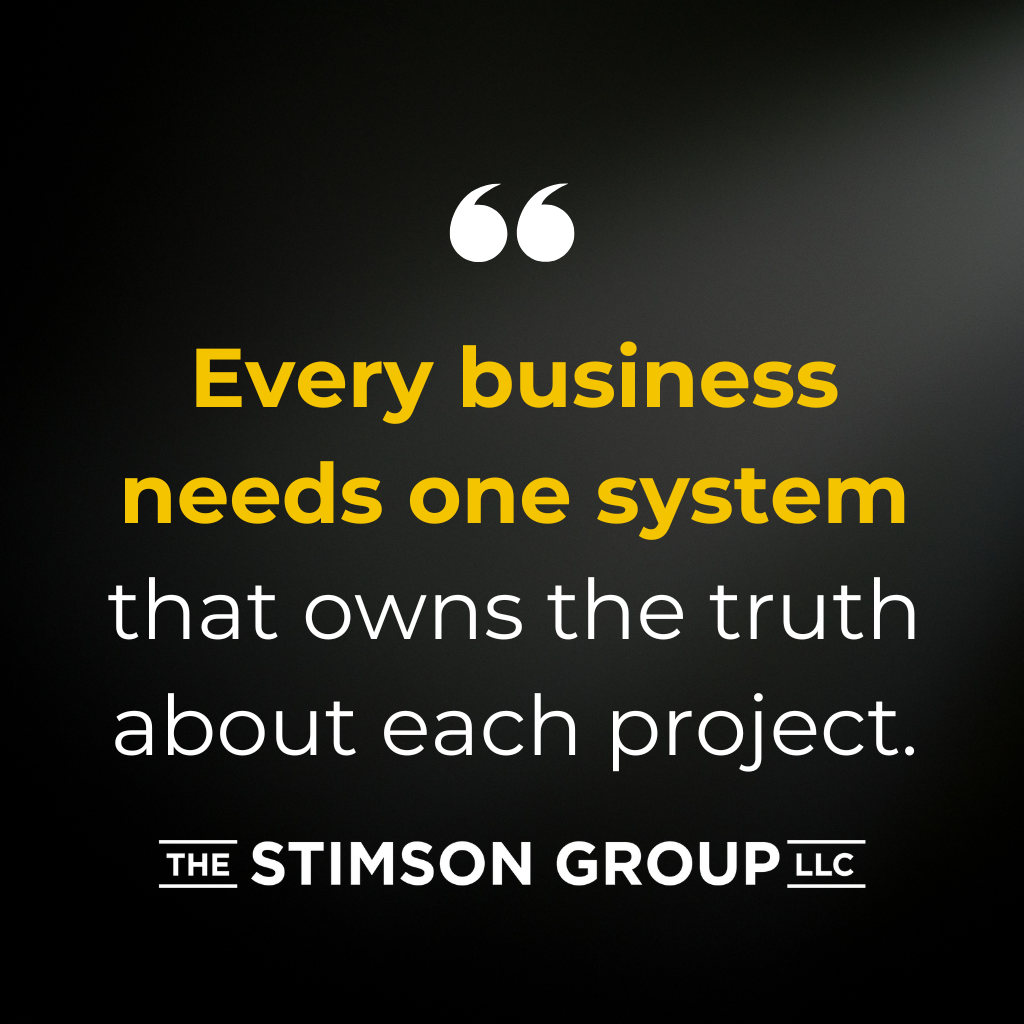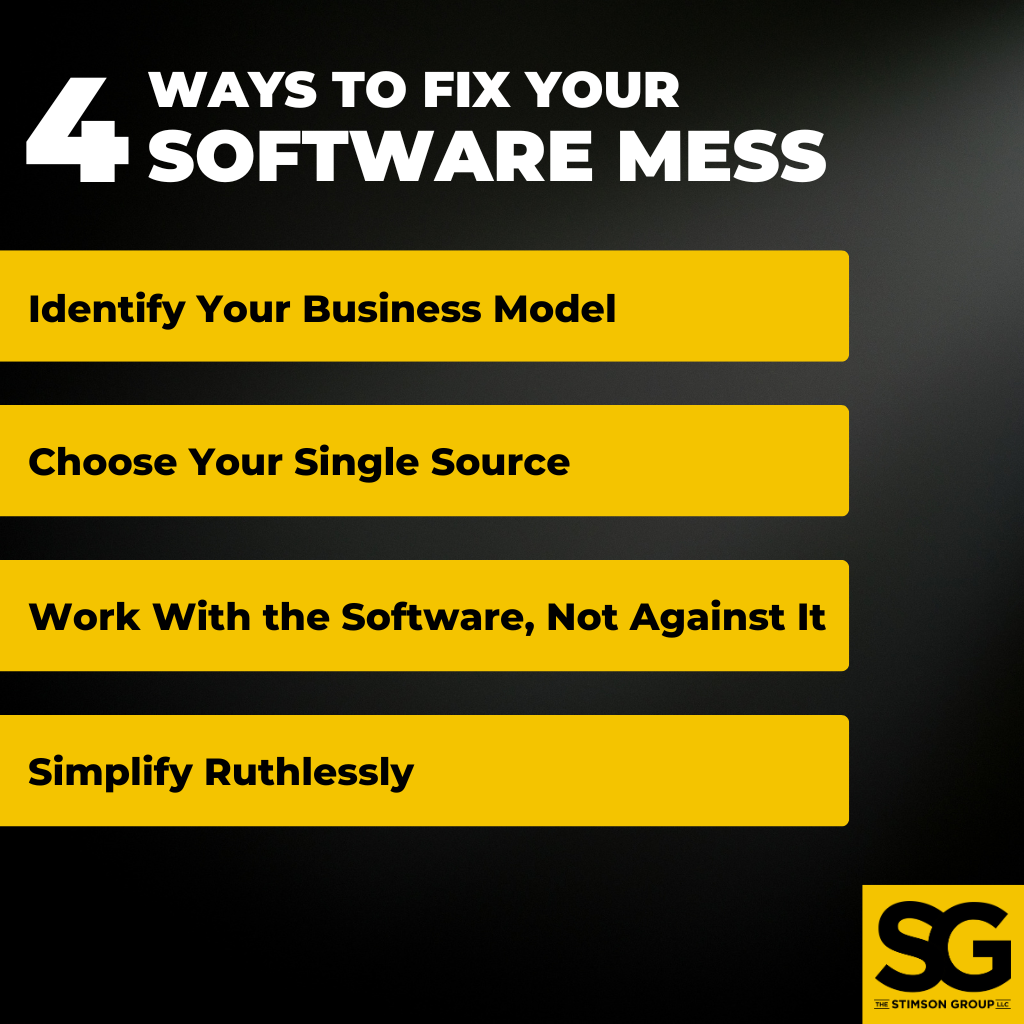
Listen instead on your Monday Morning Drive:
Software should make your business run better. Instead, most AV companies are drowning in platforms.
I recently worked with a client using 16 different software platforms for every single project. They’re down to three now. That’s as good as it gets unless you’re running pure rentals.
We have more software tools than ever before, but we still can’t answer basic questions about our projects. Information lives in silos. Teams argue about which system has the right data. Operations and sales point fingers at each other over missing details.
The solution isn’t more software. It’s understanding which platform should own your data.
Your Business Model Determines Your Software Needs
Rental Transactions
If you run rental transactions (gear out, gear back, invoice sent), you can run your entire business on QuickBooks.
Yes, QuickBooks. You can write quotes, manage inventory, track customers. It’s not sexy. It’s accounting software designed for widgets, not productions. But it works.
Most rental companies add rental management software for availability checking and better inventory tracking. That’s fine. Two systems can work together. Pick one as your primary source of truth and stick with it.
Project-Based Business
Projects have longer lifecycles than rentals. You might talk to a buyer for months before quoting. The quote goes through multiple revisions. The scope changes constantly.
Can you run this through rental management software and QuickBooks? Sure. But now you’re creating placeholder orders for opportunities that might never close. Your operations team asks every week, “Is this show happening? Where’s the labor? What’s the schedule?”
You’ve just created conflict between sales and operations. Sales information (critical for your pipeline) now lives in an operational system. The operations team sees incomplete data and assumes sales is withholding information.
Many companies add CRM software at this point. Now you have three systems. Which one has the real information?
Creative Services
You have a show with equipment, labor, and trucks. But you also have:
- Designers creating drawings
- Animators building content
- Video teams shooting and editing
- Writers developing scripts
- Producers managing timelines
Each creative department has its own task management system. Each tracks its own projects, priorities, and change orders.
You need project management software that sits above all these task systems. Your rental management software becomes just another task system underneath the project platform.
The Single Source of Truth
Every business needs one system that owns the truth about each project.
Not two systems that might match. Not three systems that should sync. One system.
For rental businesses: Your rental management system or QuickBooks can be the single source. Pick one. Port minimal data between them.
For project businesses: Your rental management system becomes the single source once an opportunity is real. CRM handles leads until they become opportunities.
For creative services businesses: Project management software owns the truth. Everything else (including rental management) feeds into it.

Why Full Integration Fails
The holy grail would be an ERP (enterprise resource planning) system that does everything. It doesn’t exist for our industry. We’re too small to justify the development cost (apologies to those developers working towards this).
Accounting is the biggest obstacle. Every QuickBooks update breaks integrations.
If someone built accounting into an industry-specific platform, they’d have to maintain that accounting system forever for a tiny market. Nobody wants that job.
Accept this: You’ll always have separate accounting software.
The Real Cost of Multiple Systems
Remember my client with 16 platforms? Calculate the waste:
- Time entering the same data multiple times
- Errors from mismatched information
- Meetings arguing about which system is right
- Projects delayed while waiting for updates
- Staff hired just to manage data between systems
Most companies can function with three systems maximum. Every system beyond that increases complexity and cost.

How to Fix Your Software Mess
Step 1: Identify Your Business Model
Are you primarily rentals, projects, or full service? Your primary business model determines your software hierarchy.
Step 2: Choose Your Single Source
Based on your model:
- Rentals: Rental management system or accounting
- Projects: Rental management system with CRM feeding it
- Creative Services: Project management platform above everything
Step 3: Work With the Software, Not Against It
When you adopt a platform, use it as designed. Stop trying to make new software work like your old software. Stop building workarounds because “that’s how we’ve always done it.”
Your processes must adapt to your software, not the other way around. Fighting your software guarantees frustration and failure.
Step 4: Simplify Ruthlessly
If you have more than three primary systems, start cutting. Someone will complain about losing their favorite feature, but the efficiency gain from simplification outweighs any individual feature loss.
The Path Forward
Software platforms are infinitely better than they were even five years ago. APIs allow systems to talk to each other. Cloud platforms provide access from anywhere. Mobile apps put information in the field.
But these tools only work when you commit to a clear information hierarchy. Every person who touches a project must know where to find and enter information. No exceptions. No shadow databases. No personal spreadsheets.
Will your software setup ever be perfect? No. Every platform will frustrate you somehow. It won’t match your exact workflow. It’ll do something differently than your last system.
That’s not the software’s fault. That’s the nature of serving a specialized industry with general tools.
Master the tools you have. Build your processes around their strengths. Maintain absolute clarity about which system owns which data.
Your bank account will thank you. Your team will thank you. Your buyers won’t care… but they’ll notice when your projects run smoother.





Leave a Reply